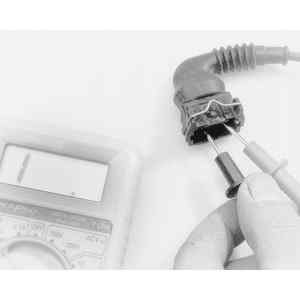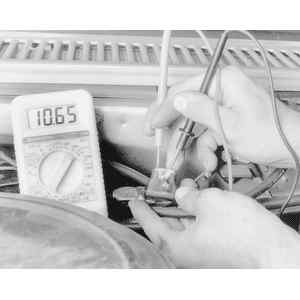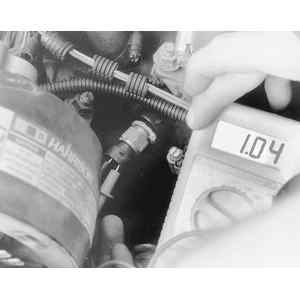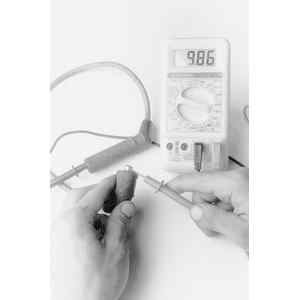| Open circuit measurement

|
This test already assumes the existence of an open in the circuit and it is used to help locate the open portion.
- Isolate the circuit from power and ground.
- Connect the self-powered test light or ohmmeter ground clip to the ground side of the circuit and probe sections of the circuit sequentially.
- If the light is out or there is infinite resistance, the open is between the probe and the circuit ground.
- If the light is on or the meter shows continuity, the open is between the probe and the end of the circuit toward the power source.
NOTE: Never use a self-powered test light to perform checks for opens or shorts when power is applied to the circuit under test. The test light can be damaged by outside power.
- Isolate the circuit from power and ground.
- Connect the self-powered test light or ohmmeter ground clip to a good ground and probe any easy-to-reach point in the circuit.
- If the light comes on or there is continuity, there is a short somewhere in the circuit.
- To isolate the short, probe a test point at either end of the isolated circuit (the light should be on or the meter should indicate continuity).
- Leave the test light probe engaged and sequentially open connectors or switches, remove parts, etc. until the light goes out or continuity is broken.
- When the light goes out, the short is between the last two circuit components which were opened.
This test determines voltage available from the battery and should be the first step in any electrical troubleshooting procedure after visual inspection. Many electrical problems, especially on computer controlled systems, can be caused by a low state of charge in the battery. Excessive corrosion at the battery cable terminals can cause poor contact that will prevent proper charging and full battery current flow.
- Set the voltmeter selector switch to the 20V position.
- Connect the multimeter negative lead to the battery's negative (–) post or terminal and the positive lead to the battery's positive (+) post or terminal.
- Turn the ignition switch ON to provide a load.
- A well charged battery should register over 12 volts. If the meter reads below 11.5 volts, the battery power may be insufficient to operate the electrical system properly.
| Low voltage measurement

|
When current flows through a load, the voltage beyond the load drops. This voltage drop is due to the resistance created by the load and also by small resistances created by corrosion at the connectors and damaged insulation on the wires. The maximum allowable voltage drop under load is critical, especially if there is more than one load in the circuit, since all voltage drops are cumulative.
- Set the voltmeter selector switch to the 20 volt position.
- Connect the multimeter negative lead to a good ground.
- Operate the circuit and check the voltage prior to the first component (load).
- There should be little or no voltage drop in the circuit prior to the first component. If a voltage drop exists, the wire or connectors in the circuit are suspect.
- While operating the first component in the circuit probe the ground side of the component with the positive meter lead and observe the voltage readings. A small voltage drop should be noticed. This voltage drop is caused by the resistance of the component.
- Repeat the test for each component (load) down the circuit.
- If a large voltage drop is noticed, the preceding component, wire or connector is suspect.
| Coolant temperature sensor resistance

|
| Spark plug wire resistance

|
CAUTION
Never use an ohmmeter with power applied to the circuit. The ohmmeter is designed to operate on its own power supply. The normal 12 volt electrical system voltage could damage the meter!
- Isolate the circuit from the vehicle's power source.
- Ensure that the ignition key is OFF when disconnecting any components or the battery.
- Where necessary, also isolate at least one side of the circuit to be checked, in order to avoid reading parallel resistances. Parallel circuit resistances will always give a lower reading than the actual resistance of either of the branches.
- Connect the meter leads to both sides of the circuit (wire or component) and read the actual measured ohms on the meter scale. Make sure the selector switch is set to the proper ohm scale for the circuit being tested, to avoid misreading the ohmmeter test value.

